 |
 |
 |
| |
ACUTE KIDNEY INJURY IN PATIENTS WITH MODERATE COVID-19 TREATED WITH RDV VERSUS SoC
|
| |
| |
CROI 2021 March 6-10 Reported by Jules Levin
Onyema Ogbuagu1, Karen T. Tashima2, Huldrych F. Günthard3, Mark McPhail4, Arun J. Sanyal5, Emon Elboudwarej6, Yuan H. Tian6, Laura H. Telep6, Susanna
K. Tan6, Anand P. Chokkalingam6, Anu O. Osinusi6, Diana Brainard6, Robert L. Gottlieb7, Antonella Castagna8, Judith A. Aberg9
1Yale University, New Haven, CT, USA, 2The Miriam Hospital, Providence, RI, USA, 3University Hospital Zurich, Zurich, Switzerland, 4King's College Hospital NHS Foundation Trust, London, UK, 5Virginia Commonwealth University Medical Center, Richmond, VA, USA, 6Gilead Sciences, Inc, Foster City, CA, USA, 7Baylor University Medical Center, Dallas, TX, USA, 8Ospedale San Raffaele, Milano, Italy, 9Icahn School of Medicine at Mt Sinai, New York, NY, USA
Background: Remdesivir (RDV), an RNA-dependent RNA polymerase inhibitor of SARS-CoV-2, and its intravenous formulation excipient, cyclodextrin, are renally cleared. We sought to characterize whether RDV was associated with worsening renal function in hospitalized patients with moderate COVID-19.
Methods: We conducted an open-label, phase 3 trial (NCT04252664) involving hospitalized patients with confirmed SARS-CoV-2 infection, evidence of pulmonary infiltrates, oxygen saturation >94% on room air and eGFR ≥50 mL/ min/1.73m2. Patients were randomly assigned 1:1:1 to receive up to 5d or 10d of RDV with standard of care (SoC), or SoC alone. Also included in this analysis were patients who enrolled in an extension phase of the trial, receiving 10d of RDV. RDV was dosed intravenously at 200 mg on d1 and 100 mg daily thereafter. Acute kidney injury (AKI) was defined as an increase in serum creatinine from baseline and classified as Stage 1 (increase > 0.3 and % change ≤25%, or % change >25% and ≤ 100%), Stage 2 (% change >100% and ≤200%), Stage 3 (% change >200%). For AKI development (ever/never for stage 1 or greater), age-adjusted risk ratios (RR) and 95% Wald confidence intervals (CI) were reported.
Results: 1005 patients (822 [83%] RDV, 183 [17%] SoC) with creatinine values collected through d14 were evaluated. Baseline patient demographics, creatinine, and eGFR were mostly similar between RDV vs SoC arms. Worsening renal function was observed less frequently in patients receiving RDV vs SOC (7% vs 10%, p=0.03, Table). After adjustment for age, there was no significant association of RDV with risk of AKI relative to SoC (RR=0.66; 95% CI 0.40, 1.09). Most AKI events were observed in patients with baseline eGFR >90 mL/min, with few events occurring in patients with a baseline eGFR 50-59 mL/min. In patients who developed Stage 3 AKI, those treated with RDV (n=2, 0.2%) returned to baseline creatinine values while those on SOC (n=4, 2%) remained elevated to d14. No difference in AKI between treatment arms was observed in patients with a history of chronic kidney disease (CKD; RDV: n=6 [12%] vs SOC: n=2 [40%] p=0.14). Older age, history of CKD, and eGFR status at baseline were independently associated with worsening renal function.
Conclusion: AKI events were observed less frequently in patients with moderately severe COVID-19 patients treated with RDV compared to SoC.
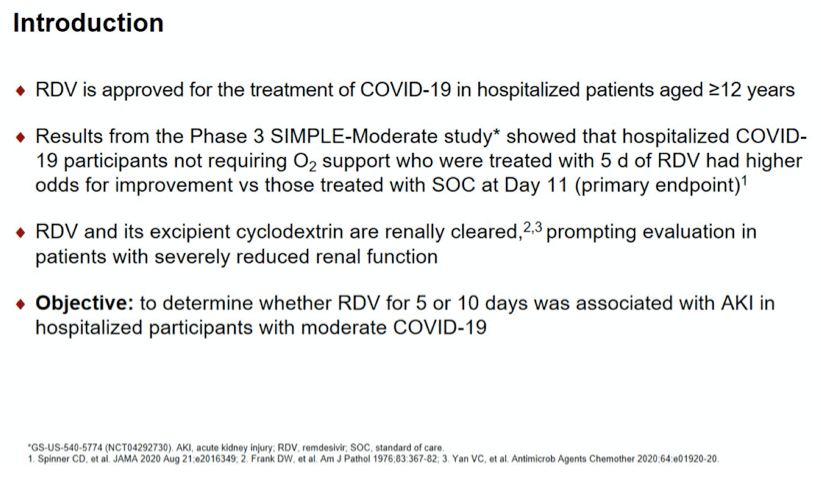
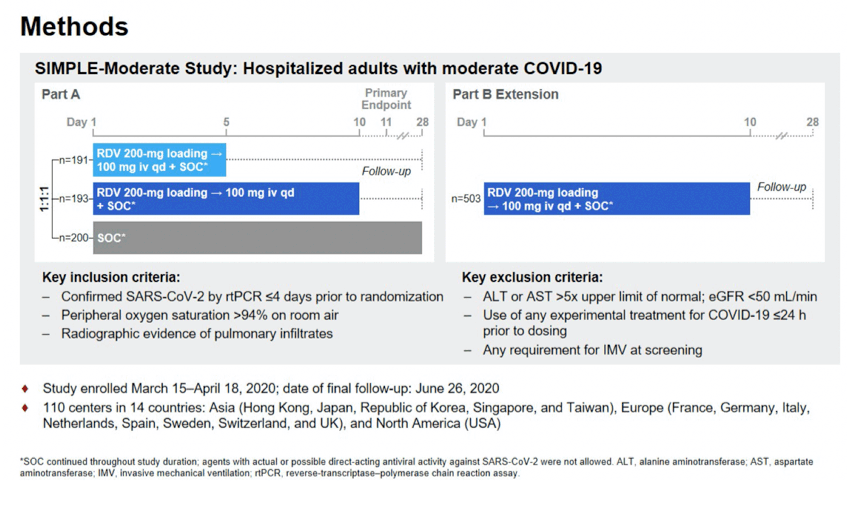
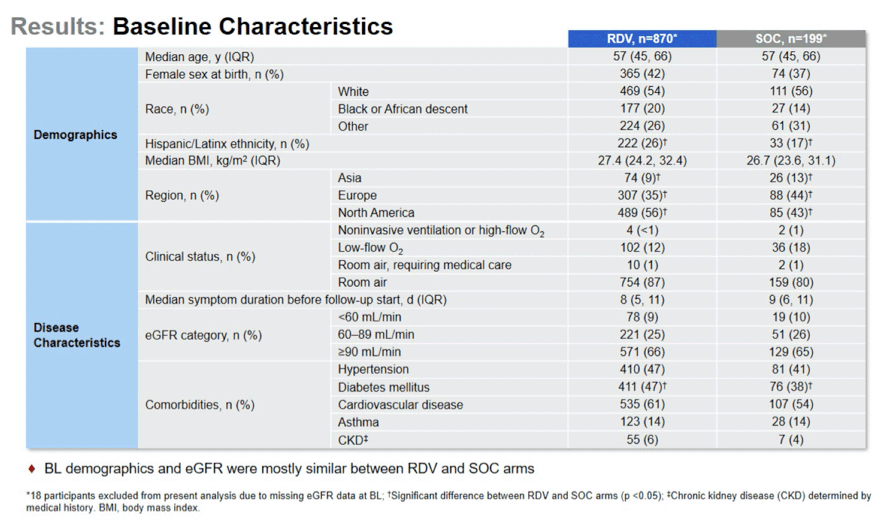
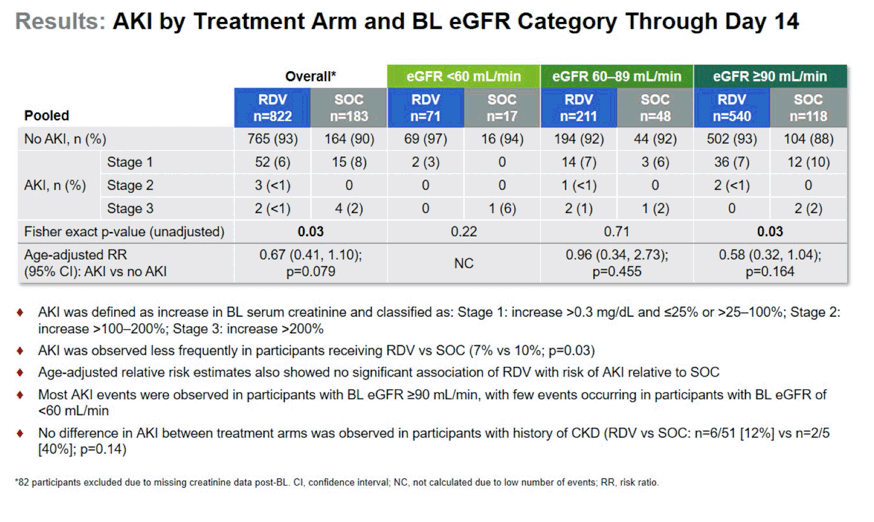
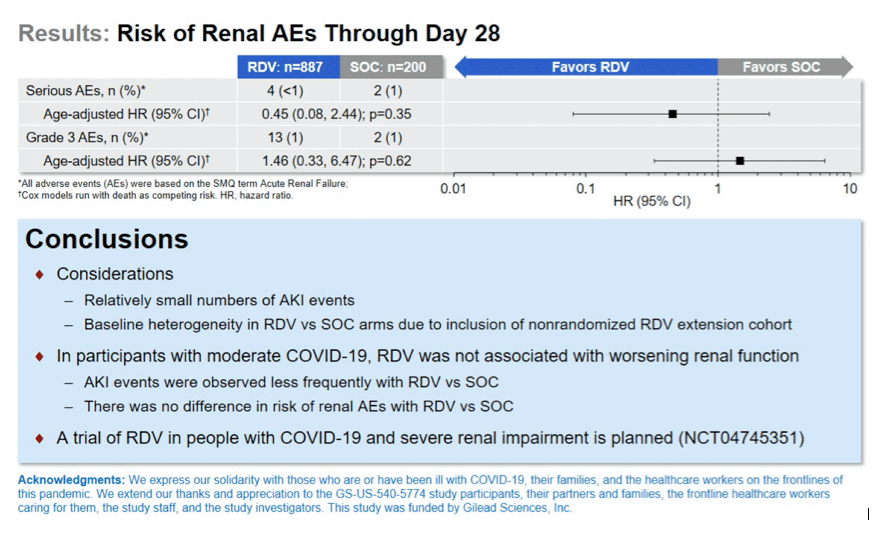
|
| |
|
 |
 |
|
|